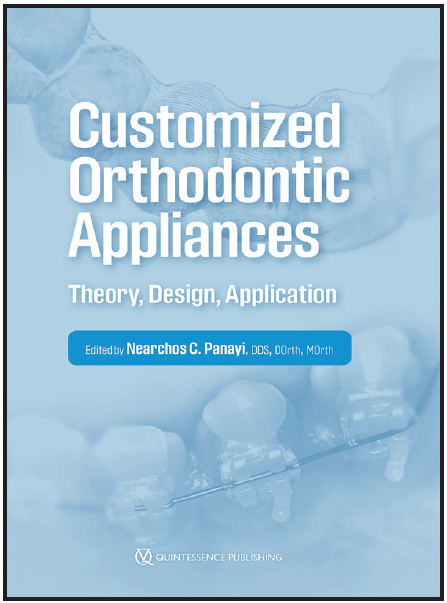BOOK REVIEWS
Customized Orthodontic Appliances: Theory, Design, Application
NEARCHOS C. PANAYI, DDS, DOrth, MOrth, Editor
232 pages, 534 illustrations. $155. 2021.
Quintessence Publishing Co., Inc.,
411 N. Raddant Road, Batavia, IL 60510.
(800) 621-0387; www.quintpub.com.
Readers of this book who are looking to incorporate digital orthodontic technologies into their practices will obtain a well-rounded education on intraoral scanning, cone-beam computed tomography, three-dimensional printing, digital workflows, custom brackets, lingual appliances, wirebending robots, artificial intelligence, and in-house aligners. Even digitally advanced orthodontists will find pearls of wisdom in every chapter.
Three chapters are of particular interest, beginning with one on the digital design and manufacturing of 3D-printed appliances. Although the fabrication of metal-printed appliances, including custom-designed expanders and mini-implant-supported devices, must be outsourced, the author also covers the design of various acrylic appliances, as well as the resins and software needed for in-office printing. His Class II T-Corrector, printed with translucent acrylic, seems to be a viable substitute for the Carriere Distalizer, with a cleverly incorporated hinge to reduce molar tipping and perhaps canine extrusion. This is consistent with the overall theme of using in-house design and printing to achieve cost savings.
The chapter on custom orthodontic brackets (“UBrackets”) covers three variations of the process, one of which involves the entire bracket being printed in-house, with a customized archform. The ability of custom brackets to improve quality or reduce treatment time is controversial at best, but to his credit, the author acknowledges that criticism and turns it into an advantage with his UBrackets software. As long as a custom bracket can avoid the need for bracket repositioning and detailing wire bends, we might not insist on extensive research to justify the choice of a low-cost system. Hybrid ceramic resins, currently employed by dentists for 3D-printed crowns, are used to make these brackets. Drawbacks of the technology (aside from its lack of wide availability) are that the resins are not optimized for orthodontic requirements such as low frictional resistance, and that higher-quality orthodontic printers are needed in the clinic—a surmountable limitation given sufficient demand.
The chapter on artificial intelligence (AI) and machine learning also deserves a close look. AI seems poised to affect the trajectory of orthodontics, as is already occurring in medicine. The authors’ examples of what is likely to happen in both the near and distant future are well worth contemplating.
ROBERT KAZMIERSKI, DMD, MS




COMMENTS
.